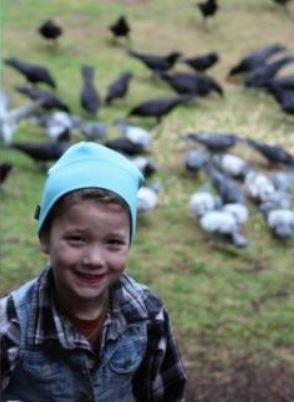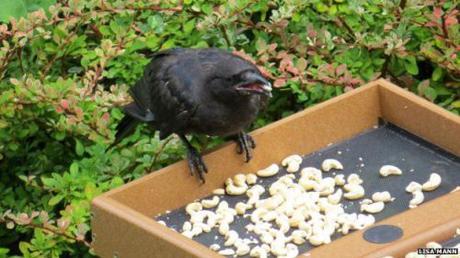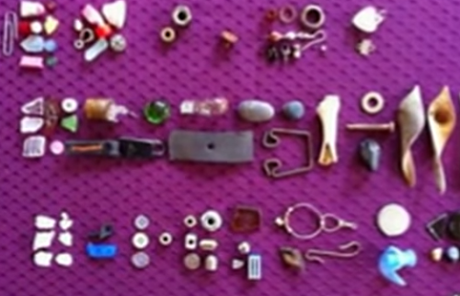Crows are believed to be among the most intelligent, if not the smartest of birds. But what happened to an 8-year-old girl in Seattle, Washington shows that, unlike so many humans, crows recognize and are grateful for acts of kindness.

Gabi Mann
It all began in 2011 when Gabi Mann first drew the attention of neighborhood crows. She was four years old and prone to dropping food. She’d get out of the car, and a chicken nugget would tumble off her lap. A crow would rush in to recover it. Soon, the crows were watching for her, hoping to catch the morsels of food that Gabi would drop.
As Gabi grew older, she began to deliberately, instead of accidentally, feed the crows. On the way to the bus stop, she and her brother would share their packed lunches with the crows. Soon, crows were lining up in the afternoon to greet Gabi’s bus, hoping for another feeding session.
Gabi’s mother Lisa didn’t mind that crows consumed most of the school lunches she packed. “I like that they love the animals and are willing to share,” she says, while admitting she never noticed crows until her daughter took an interest in them. “It was a kind of transformation. I never thought about birds.”
In 2013, Gabi and Lisa started offering food as a daily ritual, rather than dropping scraps from time to time.
Each morning, they fill the backyard birdbath with fresh water and cover bird-feeder platforms with peanuts. Gabi throws handfuls of dog food into the grass. As they work, crows assemble on the telephone lines, calling loudly to them.

That was when the gifts began.
The crows would clear the feeder of peanuts, and leave shiny trinkets on the empty tray — an earring, a hinge, a polished rock, anything shiny and small enough to fit in a crow’s mouth. There wasn’t a pattern. Gifts showed up sporadically.

Gabi carefully documents each gift with the date, time and location, and stores them in a bead storage container. Inside the box are rows of small objects in clear plastic bags.

Each gift is individually wrapped and categorized. One label reads: “Black table by feeder. 2:30 p.m. 09 Nov 2014.” Inside is a broken light bulb. Another bag contains small pieces of brown glass worn smooth by the sea, labeled “Beer colored glass.”
The crows’ gifts include beads, rocks, buttons, paper clips and earrings. There’s a miniature silver ball, a black button, a blue paper clip, a yellow bead, a faded black piece of foam, a blue Lego piece, and the list goes on. Many of them are scuffed and dirty, but to Gabi they are more valuable than gold.

Not all of the gifts are pretty trinkets. Gabi’s mom Lisa once had to dispose of a rotting crab claw that the crows brought.
The most remarkable gift of all was a camera lens cap that Lisa had lost in an alley near the family’s home. She later found it on the edge of the birdbath, cleaned and washed. Suspecting a crow had retrieved the lens cap, Lisa logged on to her computer and pulled up their bird-cam. There was the crow she suspected. “You can see it bringing it into the yard. Walks it to the birdbath and actually spends time rinsing this lens cap. I’m sure that it was intentional. They watch us all the time. I’m sure they knew I dropped it. I’m sure they decided they wanted to return it.”

Lisa and Gabi Mann
John Marzluff, professor of wildlife science at the University of Washington, specializes in birds, particularly crows and ravens. He advises, “If you want to form a bond with a crow, be consistent in rewarding them.”
What food is best? “A few peanuts in the shell,” he says. “It’s a high-energy food… and it makes noise when you throw it on the ground, so they hear it and they quickly habituate to your routine.”
Marzluff, and his colleague Mark Miller, did a study of crows and the people who feed them. They found that crows and people form a very personal relationship. “There’s definitely a two-way communication going on there,” Marzluff says. “They understand each other’s signals.” The birds communicate by how they fly, how close they walk, and where they sit. The human learns their language and the crows learn their feeder’s patterns and posture. They start to know and trust each other. Sometimes a crow leaves a gift.
But crow gifts are not guaranteed. “I can’t say they always will (give presents),” Marzluff admits, having never received any gifts personally, “but I have seen an awful lot of things crows have brought people.” Not all crows deliver shiny objects either. Sometimes they give the kind of presents “they would give to their mate”, says Marzluff. “Courtship feeding, for example. So some people, their presents are dead baby birds that the crow brings in.”
According to the National Audubon Society, crows are one of the few bird species that have been documented to recognize individual human faces.
Sources: KIRO TV and Katy Sewall for the BBC
H/t FOTM’s CSM
See also “Creation: super intelligent crow”
~Éowyn

